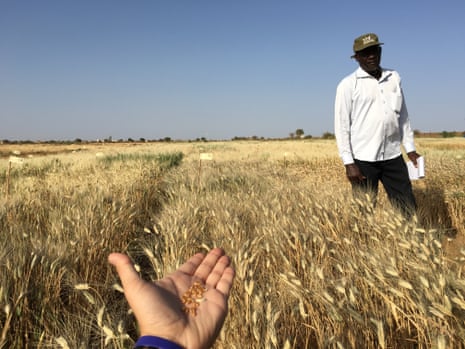In the northern Senegalese village of Ndiayene Pendao, close to the border with Mauritania, Fatouma Sow is pulling weeds. Her team of female farmers tread carefully among the tall, ripening plants as they prepare to harvest the country’s first ever crop of durum wheat.
They had grown onions and tomatoes on the one-hectare plot (2.47 acres), Sow explains, but the crops took too long to grow and disrupted the essential rice growing season. Now the wheat offers a fast-growing, lucrative alternative.
Following four years of trials, which saw thousands of wheat varieties tested in the unforgiving sub-Saharan heat, scientists have successfully turned what was first thought of as a “crazy idea” into a vital new food crop. With more than 1 million smallholders living along the Senegal River basin, which also runs through Mali and Mauritania, it was an important strategic area to trial the wheat.
The strain of wheat can withstand constant 40C temperatures, and has been developed by the International Centre for Research in the Dry Areas (Icarda). The so-called drylands cover more than 40% of the world’s land surface and despite the challenges, remain huge centres of agriculture, supporting half the world’s livestock.
Wheat is traditionally seen as a cold climate crop, with most of it grown in the northern hemisphere. To find a strain that could withstand the heat of the African savannah, a genome fingerprinting research project was led by Icarda’s Dr Filippo Bassi and Prof Rodomiro Ortiz, from the Swedish University of Agricultural Sciences.

Rather than go down a GM route, Icarda used advanced breeding techniques and its unique seedbank to combine characteristics of both modern and ancient strains.
“When we had this idea five years ago, people thought we were a bit crazy,” says Bassi. While crops such as maize shade their “tassels”, and rice droops down towards water, he explains, wheat grows upwards towards the sun.
“It just sits there taking this hammering on its head,” he says. “Inside the spike, that’s where the flower blooms, it’s where the pollen is produced and where the grain sets – all this basically inside a microwave. If you can grow it here, you can grow it anywhere.”
The wheat will fill an important gap in the regional growing season, with farmers planting two crops of rice a year either side of a fallow winter period between mid-November and March, when rice struggles to take hold.
The new variety of wheat is fast growing, and can be harvested in just 92 days, ensuring it doesn’t impact on the rice. It can produce six tonnes per hectare, despite requiring less water than rice, and contains five times more protein, as well as more vitamins and minerals. Straw from the fields will also provide an important feed for livestock.
The wheat has the potential to improve food security in other areas of the world at risk from rising temperatures, such as Sudan, Nigeria and countries in south Asia. The project won last year’s $50,000 Olam Prize for Innovation in Food Security. “As climate change causes temperatures to rise, the usefulness of these varieties will expand to nearly all countries,” Bassi says.
“The African region has, on average, the lowest agricultural productivity in the world,” says Pascal Kosuth, director of the Agropolis Foundation, which supports scientific research into agriculture and co-sponsored the Olam award. “Many countries from the continent have met increased demand for food through overseas food imports.”

Senegal alone buys nearly €30m of durum wheat a year from abroad, largely to make couscous and pasta, according to Icarda. Yet while one tonne of grain costs roughly the same as 100 packets of pasta, by growing the new wheat, farmers can transform that one tonne of grain into 2,000 packets of pasta.
For eight months of the year rice is grown on more than 200,000 hectares across the three countries. Using this land to grow wheat in between rice crops has the potential to generate 600,000 tonnes of new food, says Bassi. The next step is to scale up production by supporting farmers, developing the infrastructure from storage to milling, and creating a market for the grain.
“Developing sustainable agricultural production under severe climatic conditions and family farming systems requires an integrated effort, from plant breeding and seed systems to production systems, to product value chain as well as extension and training of farmers,” Kosuth says.
International development plays an important role in supporting villages in this part of Senegal, with signs along the highways proclaiming how corporations from Korea, Italy and France are backing various projects from renewable energy to sustainable agriculture.
Pendao doesn’t have a foreign benefactor, explains village elder Oumar Diallo. What they do have, he says, is land that’s ready to be cultivated, but to do it they need machinery, training and, of course, seed.
While the Senegalese government has acknowledged the importance of the project, it has yet to officially back the scheme. But Bassi is hopeful that international agencies and private companies will step in.
“By working closely with the farmers, we have gained their trust as they can see the benefit of planting this crop, which can be easily cultivated with minimum investment,” he says. “Now we need to help create a route to market.”

Comments (…)
Sign in or create your Guardian account to join the discussion